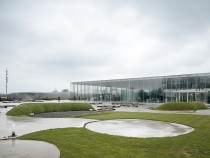
© Roland Halbe
An international competition was held in 2005 for the new branch of the Louvre in Lens. At that very early stage, the winning Japanese architects Kazuyo Sejima and Ryue Nishizawa (SANAA) had already begun their cooperation with Bollinger + Grohmann. In France, competitions for buildings receiving public funding typically stipulate in the brief that the entire planning team take part. The different services performed by the team include the design of the building and its structure, landscape architecture, lighting design, fire protection planning, building services planning, exhibition design, cost calculation, climatic planning, and last but not least, facade planning. In this case the facade planners’ task involved providing expertise in facade technology, as well as carrying out the structural engineering of the roof and facade. It became clear in the early states of planning that SANAA’s unusual design, with its low-slung building massing and slightly curved envelope, would place considerable emphasis on the design and execution of the facade details. A further challenge in the realisation of the design: in the year the competition was held, France implemented a new energy-conservation regulation based on European Union guidelines (Régulation Thermique 2005), and since the 1990s, sustainability certification (HQE – Haute Qualité Environnementale) has been required of all public buildings. Accordingly, one of the main tasks of structural engineers and facade planners is to understand and anticipate the architects’ concepts for delicate, dematerialised structures in order to be able to adjust the design for compliance with European codes, while simultaneously preserving the its identity. (Daniel Pfanner, Manfred Grohmann)






